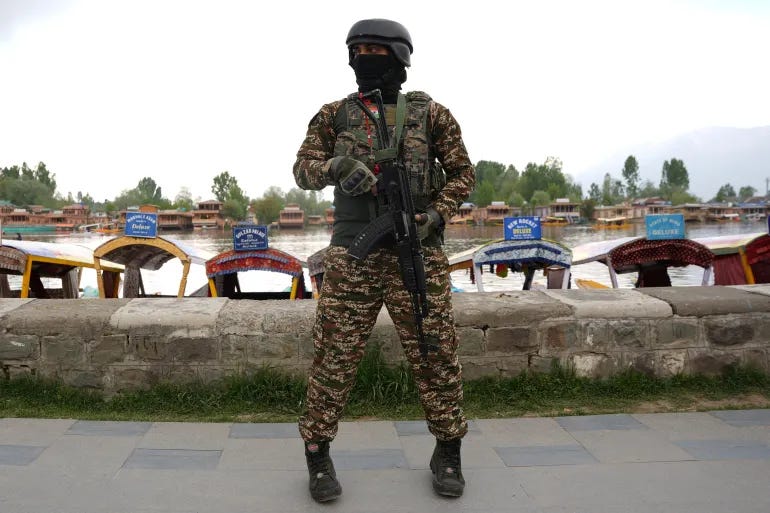The Kashmir Conflict and American Complicity
Tensions between India and Pakistan have escalated following the April 22 attack in Pahalgam, in which 26 civilians were killed in Indian-administered Kashmir. In the days since the incident, both countries have engaged in hostile rhetoric and exchanged fire across the Line of Control (LoC), the de facto border dividing Kashmir. This renewed military activity has raised concerns about the potential for further violence in an already volatile region.
To speak of Kashmir is to enter a hall of mirrors: Partition, war, betrayal, the slow drip of democracy morphing into occupation. It did not begin with slogans or gunshots. It began with a promise, and the breaking of it.
A Brief History of a Long Grief
In 1947, as British India was being carved apart, the princely state of Jammu and Kashmir stood at a crossroads. Its Muslim-majority population was pulling toward Pakistan, while its Hindu ruler hesitated. In the violence of partition, Kashmir acceded to India under duress, triggering the first India-Pakistan war. A ceasefire in 1949, brokered by the United Nations, established a Line of Control, dividing the region but promising its people a plebiscite to determine their future.
The plebiscite never came.
Instead, over decades, the Indian state tightened its grip. Article 370 of the Indian Constitution, once meant to guarantee Kashmir a special autonomous status, became more ceremonial than real. By the 1980s, rigged elections and political disenfranchisement had turned to rage. In 1989, an armed insurgency erupted, and with it came militarization on an unprecedented scale: hundreds of thousands of Indian troops, laws like the Armed Forces (Special Powers) Act that granted immunity to soldiers, and a civilian population caught in the crosshairs.
Since then, the numbers are staggering: over 70,000 dead, thousands disappeared, countless more tortured and raped. The valley became a theatre of state violence, with its people labelled as either terrorists or traitors, and its aspirations censored into silence.
And then, in August 2019, the Indian government revoked Article 370 altogether, splitting the state into two federally controlled territories. A unilateral move, carried out under military lockdown and total communication blackout. It was the political equivalent of disappearing a people in broad daylight.
The Role of the United States: Quiet Deals and Loud Silences
To understand the U.S. role in Kashmir, one must begin with omission. Washington has long tiptoed around the conflict, invoking neutrality while quietly arming the regimes involved. The U.S. sells billions in weapons to India; a country that now ranks among the top arms importers and military spenders in the world. Those arms are not only pointed at perceived external threats, but turned inward toward Kashmir, toward dissent, toward democracy itself.
The State Department, with its well-rehearsed phrases of "concern" and "monitoring the situation," has never named India’s actions in Kashmir for what they are: settler-colonialism, enforced demographic change, and systemic human rights abuse. The U.S., champion of the "rules-based order," looks the other way as India builds detention centers, jails minors, bans journalists, and turns the internet on and off like a weapon.
Why? Because geopolitics makes strange bedfellows. India is seen as a bulwark against Chinese influence, a market too big to offend, a partner too strategic to confront. Kashmir becomes collateral in this diplomacy of convenience.
Even in American academia and media, the Kashmir question is often buried beneath layers of “both-sidesism.” Rarely does the word occupation appear. Rarely is the Kashmiri right to self-determination given the dignity of serious debate.
What Can U.S.-Based Peace Activists Do?
First, decolonize your lens. Refuse the narrative of “complexity” used to paralyze action. Yes, the history is layered, but that is no excuse for inaction. At its core, Kashmir is about a people who were promised the right to choose their future, and who instead were given soldiers, curfews, and silence.
Second, follow the money. Investigate how U.S. arms manufacturers like Lockheed Martin, Boeing, Sig Sauer and Raytheon benefit from defense deals with India. Demand transparency. Demand divestment. If your university or city has funds tied up in these companies, organize. Petition. Agitate. Link Kashmir to Palestine, to Afghanistan, to Ferguson. These struggles are connected by the machinery that sustains them.
Third, speak up. Refuse to let Kashmir be erased. Host events, publish op-eds, support Kashmiri scholars and writers. Push your elected officials to address India’s human rights record; not just in campaign season, but always. Resist the temptation to reduce Kashmiri suffering to humanitarian crisis alone. This is a political fight, not a natural disaster.
Finally, learn the names. Know the stories. The boy whose eye was taken by a pellet gun. The girl whose brother was disappeared. The poet imprisoned for her words. Do not let them dissolve into statistics. Remembering is a form of resistance.
Kashmir is not voiceless. It is unheard.
And maybe this is what solidarity must become: the act of hearing across distances, across privilege, and across fear. Not to rescue, but to resonate. Not to lead, but to listen so fiercely that the echo becomes a tremor. So that the mountains, someday, can stop mourning. So that the rivers may carry more than sorrow.




